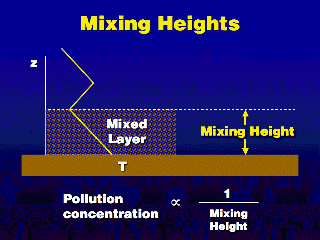 When there is an inversion aloft, the air below it is usually neutral, so
pollution emitted below the inversion base can mix throughout the layer of neutral
air below the inversion. This produces a visibly polluted layer of air next
to the ground (the mixed layer) whose depth is the mixing height,
and clear air above it. The greater the mixing height, the greater the volume
of air in which pollution emitted at the ground can mix, producing lower concentrations.
When there is an inversion aloft, the air below it is usually neutral, so
pollution emitted below the inversion base can mix throughout the layer of neutral
air below the inversion. This produces a visibly polluted layer of air next
to the ground (the mixed layer) whose depth is the mixing height,
and clear air above it. The greater the mixing height, the greater the volume
of air in which pollution emitted at the ground can mix, producing lower concentrations.
Another way to define the mixing height is the distance between the ground
and the inversion base. The location of the inversion base will be dependent
on the weather conditions that produce the inversion. Usually it's due to
air that is sinking from above, or subsidence, with stronger subsidence
producing lower inversion bases (and hence higher pollution concentrations).



 When there is an inversion aloft, the air below it is usually neutral, so
pollution emitted below the inversion base can mix throughout the layer of neutral
air below the inversion. This produces a visibly polluted layer of air next
to the ground (the mixed layer) whose depth is the mixing height,
and clear air above it. The greater the mixing height, the greater the volume
of air in which pollution emitted at the ground can mix, producing lower concentrations.
When there is an inversion aloft, the air below it is usually neutral, so
pollution emitted below the inversion base can mix throughout the layer of neutral
air below the inversion. This produces a visibly polluted layer of air next
to the ground (the mixed layer) whose depth is the mixing height,
and clear air above it. The greater the mixing height, the greater the volume
of air in which pollution emitted at the ground can mix, producing lower concentrations.